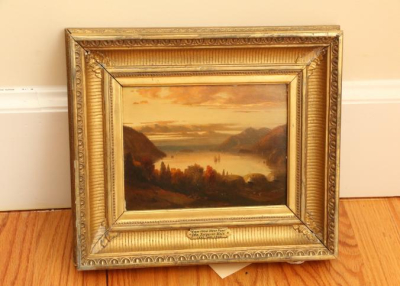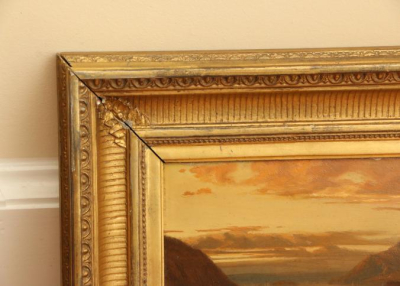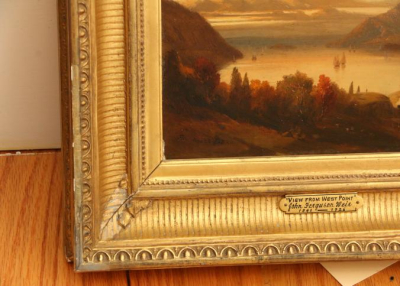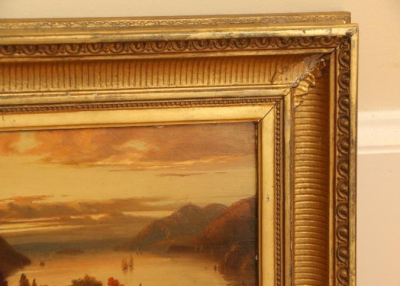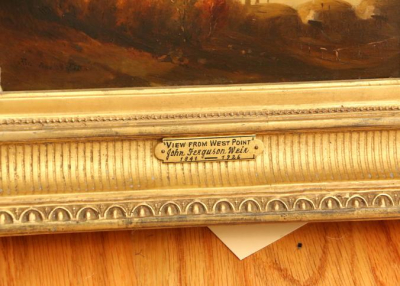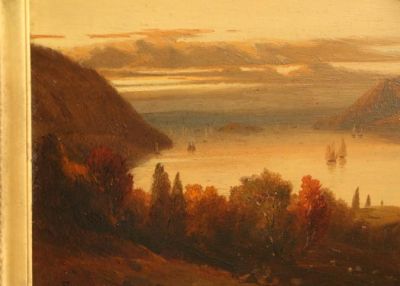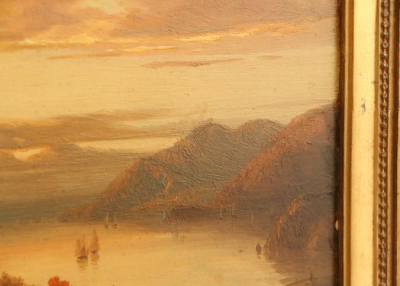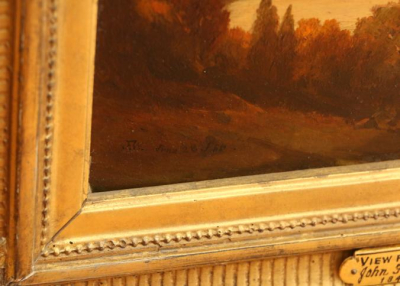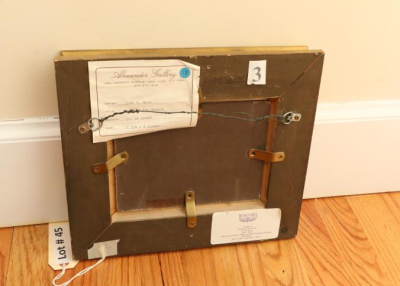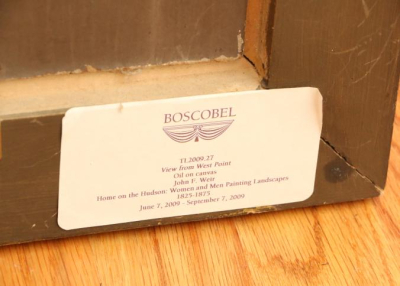Items located in Pleasant Valley, NY. Items include Hudson River School artwork, seascapes and framed lithographs. The Hudson River School of "Nature Painters" were painting from the mid-19ThC to the late 19thC. Although, they were actively painting views all across America, the scenes on the Hudson River are the most sought after. You have a rare opportunity to purchase these great "Views" now in this no-reserve auction. We also encourage you to come see us and preview the auction in-person.
Payment is due by Tuesday, May 23 at 3PM.
Pickup in Pleasant Valley, NY must be completed by Thursday, May 25 at 3PM.
All lots sold as is, where is. There is a 15% Buyers Premium for all lots purchased. Payment methods include cash, PayPal, MC, Visa, Discover or good check. You can make credit card payment online by going to your Member Area and selecting your invoice. To pay by PayPal, send money to info@aarauctions.com.
Payment is due by Tuesday, May 23 at 3PM.
Pickup in Pleasant Valley, NY must be completed by Thursday, May 25 at 3PM.
All lots sold as is, where is. There is a 15% Buyers Premium for all lots purchased. Payment methods include cash, PayPal, MC, Visa, Discover or good check. You can make credit card payment online by going to your Member Area and selecting your invoice. To pay by PayPal, send money to info@aarauctions.com.
Auction Info
Items located in Pleasant Valley, NY. Items include Hudson River School artwork, seascapes and framed lithographs. The Hudson River School of "Nature Painters" were painting from the mid-19ThC to the late 19thC. Although, they were actively painting views all across America, the scenes on the Hudson River are the most sought after. You have a rare opportunity to purchase these great "Views" now in this no-reserve auction. We also encourage you to come see us and preview the auction in-person.
Payment is due by Tuesday, May 23 at 3PM.
Pickup in Pleasant Valley, NY must be completed by Thursday, May 25 at 3PM.
All lots sold as is, where is. There is a 15% Buyers Premium for all lots purchased. Payment methods include cash, PayPal, MC, Visa, Discover or good check. You can make credit card payment online by going to your Member Area and selecting your invoice. To pay by PayPal, send money to info@aarauctions.com.
Payment is due by Tuesday, May 23 at 3PM.
Pickup in Pleasant Valley, NY must be completed by Thursday, May 25 at 3PM.
All lots sold as is, where is. There is a 15% Buyers Premium for all lots purchased. Payment methods include cash, PayPal, MC, Visa, Discover or good check. You can make credit card payment online by going to your Member Area and selecting your invoice. To pay by PayPal, send money to info@aarauctions.com.
Categories:
Framed 19thC o/b signed "JF (combined) W" and dated "June 28th 65" lower left. John Ferguson Weir (1841-1925). "View From West Point 1865." Featured in the Exhibition "This Perfect River-View": The Hudson River School and Contemporaries in Private Collections in the Highlands. The exhibit ran from July 20th to November 25, 2007 at the Putnam County Historical Society & Foundry School Museum in Cold Spring, NY. This painting was featured as plate #26 on page 43 of the 67 page catalog for the exhibition. It also bears the #3 tag from being on exhibit at the Historic Boscobel Home on the Hudson in Cold Spring, NY.
Boscobel label indicating that this work of art was part of the Exhibit: Home on the Hudson: Women and Men Painting Landscapes 1825-1875" that was held June 7, 2009 - September 7, 2009. The original Alexander Galleries label is affixed to the back. Bio AskArt: A painter, sculptor, writer, and teacher, John Weir was a highly talented man whose painting was overshadowed by his father, Robert Weir, the long-time West Point Academy drawing teacher, and his brother, J Alden Weir, well-known impressionist painter.
His distinguished reputation was primarily based on his accomplishments as a teacher and administrator. For many years, from 1869 to 1913, John Weir was the Director of the Yale University School of Fine Arts. He was also a commissioner of the art exhibition at the Centennial Exposition in Philadelphia.
Weir was born at West Point, New York, and by age 20, had a studio in New York City in the Tenth Street Studio Building, the first building in America dedicated to art studios, and there he associated with many leading painters of the day.
He earned attention early in his career for paintings of industrial scenes, some of the earliest in American art history. Examples are "The Gun Foundry," 1866 in the Putnam County, New York Historical Society, and "Forging the Shaft," of 1867, which was subsequently destroyed. He did them in monumental sizes with much chiaroscuro (contrasting light and dark) effect, showing labor figures in the fiery glow of furnaces.
He spent a year in Europe, painting panoramic landscapes, and then returned to New Haven, Connecticut to become associated with its School of Fine Arts.
Much of the remainder of his painting was impressionist in style and depicted quiet landscapes, especially of the Hudson River region. These pieces, unlike his industrial scenes, did not much distinguish him from the numerous other painters doing the same style and similar subject matter. He also painted portraits including that of Yale president Theodore Dwight Woolsey and Benjamin Silliman, a professor.
Weir died in Providence, Rhode Island in 1926. Note: catalog says oil on canvas. But, it appears to be oil on board. 5.5x7.75" sight.
. 5.5" x 7.75" board
More Details
Framed 19thC o/b signed "JF (combined) W" and dated "June 28th 65" lower left. John Ferguson Weir (1841-1925). "View From West Point 1865." Featured in the Exhibition "This Perfect River-View": The Hudson River School and Contemporaries in Private Collections in the Highlands. The exhibit ran from July 20th to November 25, 2007 at the Putnam County Historical Society & Foundry School Museum in Cold Spring, NY. This painting was featured as plate #26 on page 43 of the 67 page catalog for the exhibition. It also bears the #3 tag from being on exhibit at the Historic Boscobel Home on the Hudson in Cold Spring, NY.
Boscobel label indicating that this work of art was part of the Exhibit: Home on the Hudson: Women and Men Painting Landscapes 1825-1875" that was held June 7, 2009 - September 7, 2009. The original Alexander Galleries label is affixed to the back. Bio AskArt: A painter, sculptor, writer, and teacher, John Weir was a highly talented man whose painting was overshadowed by his father, Robert Weir, the long-time West Point Academy drawing teacher, and his brother, J Alden Weir, well-known impressionist painter.
His distinguished reputation was primarily based on his accomplishments as a teacher and administrator. For many years, from 1869 to 1913, John Weir was the Director of the Yale University School of Fine Arts. He was also a commissioner of the art exhibition at the Centennial Exposition in Philadelphia.
Weir was born at West Point, New York, and by age 20, had a studio in New York City in the Tenth Street Studio Building, the first building in America dedicated to art studios, and there he associated with many leading painters of the day.
He earned attention early in his career for paintings of industrial scenes, some of the earliest in American art history. Examples are "The Gun Foundry," 1866 in the Putnam County, New York Historical Society, and "Forging the Shaft," of 1867, which was subsequently destroyed. He did them in monumental sizes with much chiaroscuro (contrasting light and dark) effect, showing labor figures in the fiery glow of furnaces.
He spent a year in Europe, painting panoramic landscapes, and then returned to New Haven, Connecticut to become associated with its School of Fine Arts.
Much of the remainder of his painting was impressionist in style and depicted quiet landscapes, especially of the Hudson River region. These pieces, unlike his industrial scenes, did not much distinguish him from the numerous other painters doing the same style and similar subject matter. He also painted portraits including that of Yale president Theodore Dwight Woolsey and Benjamin Silliman, a professor.
Weir died in Providence, Rhode Island in 1926. Note: catalog says oil on canvas. But, it appears to be oil on board. 5.5x7.75" sight.
. 5.5" x 7.75" board
High Bid:
$7,200.00 – briggs
Auction Type: One Lot
Quantity: 1
Bidding has closed on this lot

















